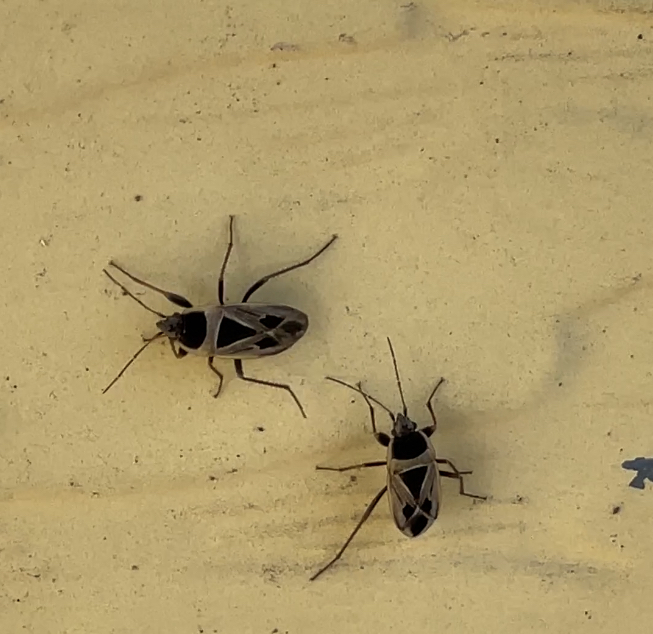As we all know, Oregon has a thriving agricultural economy, and here in the Willamette Valley one particular crop reigns supreme over all others, and that is grass seed. In fact, Linn County is often referred to as the “Grass Seed Capital of the World”. If that’s true I’d go out on a limb and say why stop there? “Grass Seed Capitol of the Entire Solar System” is just as true and much more grand.
It’s not all sunshine and fescue. There are drawbacks when you occupy the monocotyl throne. The first is allergies, obviously, and the second is a little bug that has gone under the radar, but in the past few years has become a greater and greater nuisance in and around people’s homes at the end of the summer/beginning of the fall. That little bug is the Mediterranean Seed Bug and it’s bringing friends.
The Mediterranean seed bug, or MSB for brevity’s sake, is a small true bug of the family Rhyparochromidae. They’re small, 7-8mm long, and tan with black markings. Think small, black and tan, Box elder bug. They aren’t considered an agricultural pest per se because their food mostly consists of fallen seed that they glean from the ground, but they are certainly agriculturally adjacent.
Most years they aren’t so bad. Sometimes fall comes and goes without much incident and we see a few MSB here and there but nothing significant. Then there are the years when everything falls into place. The winter was just warm enough. The spring was just springy enough. Summer hits just right. Then, bam! Those seed bugs are migrating off of those fields in droves. The ground can be crawling with them as they flee the dry fields in search of moisture and harborage. There are so many that the houses are just another obstacle in the way and the bugs find their way under doors and into windows. There’s no stopping their onslaught before it runs its course.
So, we’re issuing this message as a warning. If this year proves to be one of those bad ones (and signs are pointing to yes) we want you to be as prepared as possible. We put together some helpful hints to help you manage the bugs so you can enjoy your September.
How to keep Mediterranean Seed Bugs out of your home?
- Seal Entry Points: Start by inspecting your home for any cracks, gaps, or openings that might serve as entry points for these bugs. Seal them up with caulk or weatherstripping to keep the bugs outside where they belong.
- Outdoor Maintenance: Trim back vegetation, including bushes and trees, that may be in close proximity to your home. Mediterranean Seed Bugs are outdoor insects, so creating a buffer zone between your house and greenery can discourage them from venturing inside.
- Screen Your Windows: Ensure your windows and doors are fitted with tight-fitting screens that are free from tears or gaps. This will help prevent bugs from entering your home while still allowing fresh air to circulate.
- Vacuum Regularly: If you notice these bugs indoors, use a vacuum cleaner to remove them gently. Be sure to empty the vacuum bag or canister outside to prevent them from re-entering your living space.
- Professional Pest Control: If Mediterranean Seed Bugs continue to be a problem, don’t hesitate to reach out to our experienced pest control team. We have the knowledge and tools to effectively manage infestations and keep your home pest-free.
Living with Mediterranean Seed Bugs in September doesn’t have to be a hassle. By taking proactive measures and following our expert advice, you can enjoy a bug-free home during this late-summer season. If you ever find yourself overwhelmed or need professional assistance, don’t hesitate to contact Good Earth Pest Company. We’re here to help you reclaim your home from these uninvited guests and enjoy the beauty of September without the pesky interruptions.
I’m partial to a perennial ryegrass myself,
Adam Hiddleson



